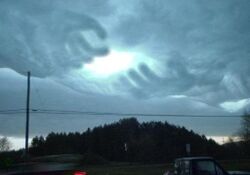Cloud gazing
Cloud gazing, or Aeromancy, is the scientific study of cloud formations. This is often done due to the belief in a connection between the atmospheric conditions and terrestrial matters.
Cloud gazing has played an important part in human history, having various regional branches including Indian or Chinese aeromancy, and European aeromancy. Cloud gazing has in fact been instrumental in shaping the course of human history.
Etymology
Aeromancy comes from the Greek ἀήρ, ἀέρος, (aer, aeros) meaning "air" and the verb Μανία (mania) meaning "madness, frenzy". This reflects that early cloud gazers looked at clouds with a fervent passion — a passion that is still matched in professional cloud-gazing today.
The first recorded instance of cloud gazing as a modern science being used was found in Chambers, Cycl. Supp, 1753. It was defined as "That department of ʃience which trætſ of the atmoſfere". This has often been referred to as an early form of meteorology, although it has been suggested that this was generally just developed from awkward social occasions where everyone just stood around and talked about the weather.
Current practice
Cloud gazing can be practiced by anyone, given sufficient clouds. It can be done indoors, though more commonly practiced outside. Reading the clouds for amusement is not a new pastime, and engaged in by many as a hobby, but professional cloud reading is a very serious business, with stronger academic roots than ever before, and providing lucrative opportunities after study. The cloud gazing business in the US generates approximately 15% of the gross national product.
Cloud gazers have to hone a variety of skills and talents through an intense and rigorous pursuit of study in school. Some suggest that cloud gazers are born, not made. It does require prodigious demands on the faculties of the cloud gazer to pursue gazing as a career choice. Cloud gazers who wish to go professional after school will have to be versed in all the major cloud forms, not only in identification but reading and predictive morphology, as well as being able to demonstrate a clear understanding of the portents the clouds forewarn. Generally practitioners don't travel far from their universities or colleges where they got their degree, since climate patterns in other areas may prove obstacles to what they're familiar with, while for others this is a reason to voyage out.
Of course Masters and PhDs are also offered at some schools, and are generally better paid after school, as their advanced studies will often specialize in particular concentrations, such as Pileus or Cumulus. Very specialized fields, like Altostratus Undulatus and Cumulonimbus Calvus are offered at fewer universities, and often students must go to specialty cloud gazing and reading schools for their degree.
Predictive morphology
There are various methods used in divination from cloud formations, however the Encyclopedia of Occultism & Parapsychology, Fifth Edition, Vol. 2 edited by J. Gordon Melton, notes:
| “ | In order to divine terrestrial events from the atmospheric conditions the diviner or gazer must first empty their mind of all conscious thought. This is a skill that takes some practitioners many years of effort, however others are more naturally inclined toward lack of thought initially. The diviner now looks at the pattern of clouds in the sky and allows the imagination to play around the colours and shapes suggested by them. They might look like a letter, a heart shape, or a fluffy white thingy. These shapes are then interpreted intuitively or by means of a fairly standard system of symbolism, such as: snake (enmity or falsehood), spade (good fortune through industry), mountain (journey of hindrance), or fluffy white thing (change, success). |
” |
Melton's notion that readers give intuitive interpretations reflects his unfamiliarity with cloud reading; most readers use the standard symbols that have been handed down through several generations. There are, however, many who prefer to read by feel and intuition, as stated by Melton. The most common readings however are:
| Atmospheric conditions | Prediction |
|---|---|
| Clear skies Sun shining |
The sun will set within 12 hours. |
| Clear skies Stars/moon shining |
The sun will rise within 12 hours (It may be more approriate to take up Astrology.) |
| Significant cloud cover Dark grey colour |
It may start raining |
| Significant cloud cover Water falling from sky |
It will stop raining eventually |
Early Origins
Cloud gazing, in its broadest sense, is the search for meaning in the cloud formations. It has therefore been argued that aeromancy began as a study as soon as human beings made conscious attempts to measure and record their experiences staring at clouds. This argument is obviously idiotic and can be dismissed out of hand as the ravings of an individual with extraordinarily low IQ.
Cloud gazing has been dated back to Israelite times. It was mentioned in Deuteronomy 18 as being condemned by Moses, who felt that staring at stone tablets with a dozen or so commandments on them was better than staring into the sky and relaxing.
It is also condemned by Albertus Magnus in Speculum Astronomiae, who describes the practice as a derivative of nigromancy (a form of divination via necromancy). Why he believed dead people were pushing around the clouds and making them form into different shapes is still unknown, but it is believed to be related to his own practice of al-essdy (divination via hallucinogenics).
In Renaissance magic, aeromancy was classified as one of the seven "forbidden arts," along with necromancy, geomancy, hydromancy, pyromancy, chiromancy (palmistry), and masturbation.
See also
| Featured version: 8 November 2014 | |
| This article has been featured on the main page. — You can vote for or nominate your favourite articles at Uncyclopedia:VFH. | |




